Quantitative Research on Roof Deformation and Temporary Support Stiffness in Deep-Mine Gob-Side Entry Retaining by Roof Cutting
Abstract
:1. Introduction
2. Evolution Characteristics of the Roof Structure in Gob-Side Entry Retaining by Roof Cutting
2.1. Engineering Background
2.2. Analysis of Roof Structure Characteristics in Different Stages
- (1)
- Roadway excavation stage: The additional stress caused by excavation disturbance is relatively small, and the direct roof is supported by solid coal at both ends, with limited expansion of internal cracks. It remains stable under the support of the solid coal at both ends. In this stage, the immediate roof can be simplified as a beam structure with both ends fixed, as shown in Figure 5a.
- (2)
- Pre-splitting roof cutting stage: In this stage, the advanced working face implements pre-splitting cutting on the roadway roof, severing the mechanical connection between the roadway roof and the working face roof. The pre-splitting roof cutting holes are generally at an angle of 70~80° with the roadway roof [23,24]. Under the action of the self-weight of the overlying strata and the mining support pressure, the roadway roof at both ends remains supported by solid coal after the advanced working face pre-splitting roof cutting. This stage generally focuses on controlling the stability of the roof and increasing temporary support within the roadway. Temporary support often uses single-leg supports and stacking supports, which can simplify the roadway roof structure into a cantilever beam with one end fixed and the other end simply supported, as shown in Figure 5b.
- (3)
- Primary mining retention stage: Due to the influence of the working face mining support stress and the large turning subsidence space of the roadway roof, the movement of the roadway roof is intense and prone to significant deformation, which is a critical support stage during the retention process. To control the subsidence of the roadway roof, temporary support is usually increased within the roadway. This often involves the use of multiple rows of single-leg supports or two rows of stacking supports. Therefore, the roadway roof structure in this stage can be simplified as a cantilever beam with one end fixed (solid coal), as shown in Figure 5c.
- (4)
- Retaining stability stage and secondary mining advanced impact stage: After the roadway is stabilized, the caved gangue fills the gob area, providing support for the roadway roof on the cutting side until the secondary reuse of the roadway ends. Therefore, during the retaining stability and the secondary mining advanced impact stage, the retaining roadway roof can be simplified as a beam structure with one end fixed and the other end simply supported, as shown in Figure 5d.

2.3. Roadway Roof Deformation Law of GERRC
2.3.1. Model Establishment
2.3.2. Roadway Roof Deformation Laws during Roadway Retaining

3. Roof Movement Mechanical Model of GERRC
3.1. Mathematic Expression of Shear Stress
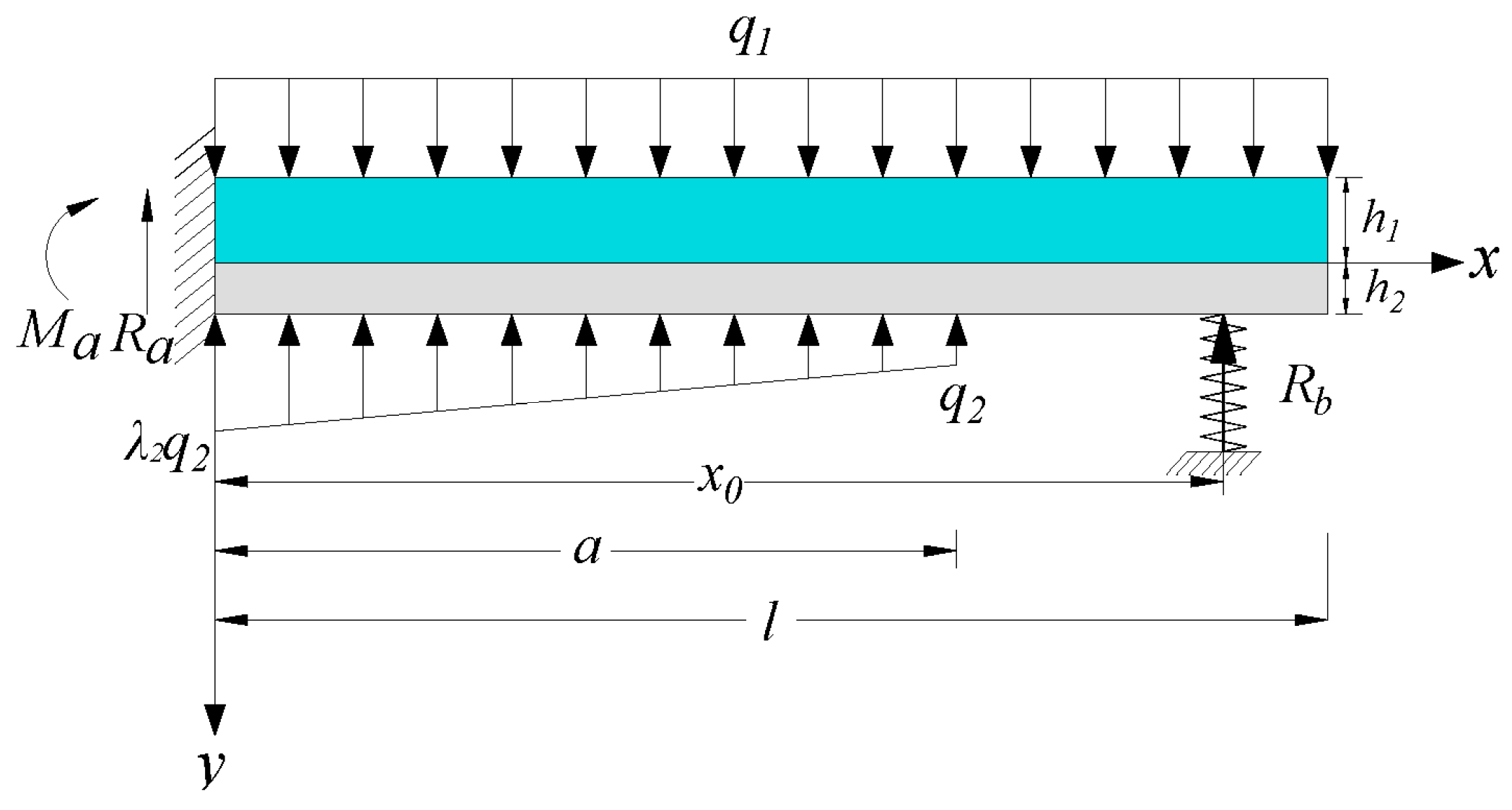
3.2. Relationship between Roadway Roof Deformation and Support Stiffness
4. Roof Control Effect during Retention Stage
4.1. Roof Support Parameters during Primary Mining Retention Stage
4.2. Roof Control Effect during Primary Mining Retention Stage
- ①
- Stress analysis of reinforcing anchor cables
- ②
- Analysis of stack-type support resistance
5. Main Conclusions
Author Contributions
Funding
Institutional Review Board Statement
Informed Consent Statement
Data Availability Statement
Acknowledgments
Conflicts of Interest
References
- Zhang, Z.Z.; Bai, J.B.; Wang, X.G.; Xu, Y.; Yan, S.; Liu, H.L.; Wu, W.; Zhang, W.G. Review and development of surrounding rock controltechnology for gob-side entry retaining in China. J. China Coal Soc. 2023, 48, 3979–4000. [Google Scholar]
- He, M.C.; Chen, S.Y.; Guo, Z.B.; Yang, J.; Gao, Y.B. Control of surrounding rock structure for gob side entry retaining by cutting roof to release pressure and its engineering application. Technol. J. China Univ. Min. 2017, 46, 959–969. [Google Scholar]
- He, M.; Gao, Y.; Gai, Q. Mechanical principle and mining methods of automagical entry formation without coal pillars. Coal Sci. Technol. 2023, 51, 19–30. [Google Scholar]
- He, M. Theory and engineering practice for non-pillars mining withautomagical entry formation and 110 mining method. J. Min. Saf. Eng. 2023, 40, 869–881. [Google Scholar]
- Gao, Y.B.; Guo, Z.B.; Yang, J.; Wang, J.W.; Wang, Y.J. Steady analysis of gob-side entry retaining formed by roof fracturing and control techniques by optimizing mine pressure. J. China Coal Soc. 2017, 42, 1672–1681. [Google Scholar]
- Gao, Y.; Wang, Q.; Yang, J.; Ding, W.; Fu, Q.; Xu, X. Mechanism of deformation and pressure relief control of dynamic gob-side entry surroundings in fully-mechanized caving mining for extra-thick coal seam. Coal Sci. Technol. 2023, 51, 83–94. [Google Scholar]
- Yang, J.; Fu, Q.; Gao, Y.; Cheng, Y.; Zhang, J. Research on roof deformation laws and mechanism in a non-pillar mining method with entry automatically formed during the whole cycle. J. China Coal Soc. 2020, 45, 87–98. [Google Scholar]
- Wei, Q.-L.; Wang, Y.-J.; Yang, J.; Gao, Y.-B.; Hou, S.-L.; Qiao, B.-W. Roof deformation mechanism and control measures of pillarless mining withgob-side entry retaining by roof cutting and pressure relief. Rock Soil Mech. 2020, 41, 989–998. [Google Scholar]
- Chen, S.Y.; He, M.C.; Guo, Z.B.; Yang, H.; Yang, J. Control Countermeasures of Surrounding Rock in Deep Gob-side Entry Retaining by Cutting Roof. Adv. Eng. Sci. 2019, 51, 107–116. [Google Scholar]
- Chen, S.Y.; He, M.C.; Wang, H.J.; Yuan, G.X.; Zhao, F.; Guo, Z.B. Coordination control and stress evolution of surrounding rock of gob-side entry retaining cutting roof in deep mine. J. Min. Saf. Eng. 2019, 36, 660–669. [Google Scholar]
- Guo, Z.; Zhao, Y.; Yang, D.; Gao, J.; Yin, S.; Kuai, X. Study on roof deformation mechanism and control technology of cross-fault roof cutting and pressure relief self-forming roadway. Coal Sci. Technol. 2024, 52, 14–28. [Google Scholar]
- Liu, X.; Hua, X.; Yang, P.; Yang, S.; Ma, Y. A quantitative study on roof dislocation criterion and support parameters of entry retaining by roof cutting in deep mine. J. Min. Saf. Eng. 2021, 38, 1122–1133. [Google Scholar]
- Chen, L.; Kang, H.; Jang, P.; Li, W.; Yang, J.; Zhen, Y. Deformation and failure characteristics and control technology of surrounding rocks in deeply gob-side entry driving. J. Min. Saf. Eng. 2021, 38, 227–236. [Google Scholar]
- He, M.; Wu, Y.; Gao, Y.; Tao, Z. Research progress of rock mechanics in deep mining. J. China Coal Soc. 2024, 49, 75–99. [Google Scholar]
- Xie, H.; Zhang, R.; Zhang, Z.; Gao, M.; Li, C.; He, Z.; Liu, T. Reflections and explorations on deep earth science and deep earth engineering technology. J. China Coal Soc. 2023, 48, 3959–3978. [Google Scholar]
- Skrzypkowski, K. Comparative Analysis of the Mining Cribs Models Filled with Gangue. Energies 2020, 13, 5290. [Google Scholar] [CrossRef]
- Shan, Z.; Porter, I.; Nemcik, J.; Baafi, E. Investigating the behaviour of fibre reinforced polymers and steel mesh when supporting coal mine roof strata subject to buckling. Rock Mech. Rock Eng. 2019, 52, 1857–1869. [Google Scholar] [CrossRef]
- Sinha, S.; Chugh, Y.P. An evaluation of roof support plans at two coal mines in Illinois using numerical models. Int. J. Rock Mech. Min. Sci. 2016, 82, 1–9. [Google Scholar] [CrossRef]
- Zuo, J.P.; Wen, J.H.; Hu, S.Y.; Zhao, S.K. Theoretical model and simulation study of uniform strength beam support in deep coal mine roadway. J. China Coal Soc. 2018, 43, 1–11. [Google Scholar]
- Gao, Y.B.; Yang, J.; Zhang, X.Y.; Xue, H.J.; He, M.C. Study on Surrounding Rock Control of Roadways in Deep Coal Mines Based on Roof Cutting and Pressure Release Technology by Directional Tensile Blasting. Chin. J. Rock Mech. Eng. 2019, 38, 2045–2056. [Google Scholar]
- Zhao, Y.; Zhang, N.; Zhen, X.; Baoyu, L. Structural optimization of overlying strata for gob-side entry retaining in 1000 m deep mine with direct thick and hard roof. J. Min. Saf. Eng. 2015, 32, 714–720. [Google Scholar]
- Wang, Q.; Zhang, P.; Jiang, Z.H.; He, M.; Li, S.; Wang, Y.; Jiang, B. Automatic roadway formation method by roof cutting with high strength bolt-grouting in deep coal mine and its validation. J. China Coal Soc. 2021, 46, 382–397. [Google Scholar]
- Chen, S.Y.; Zhao, B.; Yuan, Y.; He, M.C.; Guo, Z.B.; Zhao, F. Engineering experiment on gob-side entry retaining byroof cutting of deep mining face in Cheng jiao coalmine. J. Min. Saf. Eng. 2021, 38, 121–129. [Google Scholar]
- Hu, C.; Wang, J.; He, M.; Wang, X.; Wang, J.; Zhang, Z. Study on key parameters of self-formed roadway without coal pillar by roof cutting and pressure relief in medium and thick coal seam. Coal Sci. Technol. 2022, 50, 117–123. [Google Scholar]
- Liu, X.; Hua, X.; Yang, P.; Huang, Y. A study of the mechanical structure of the immediate roof during the whole process of non-pillar gob-side entry retaining by roof cutting. Energy Explor. Exploit. 2020, 38, 1706–1724. [Google Scholar] [CrossRef]
- Hua, X.Z.; Liu, X.; Huang, Z.G.; Yang, P.; Ma, Y. Stability mechanism of non-pillar gob-side entry retaining by roof cutting under the coupled static-dynamic loading. J. China Coal Soc. 2020, 45, 3696–3708. [Google Scholar]
- Tahmasebinia, F.; Yang, A.; Feghali, P.; Skrzypkowski, K. A Numerical Investigation to Calculate Ultimate Limit State Capacity of Cable Bolts Subjected to Impact Loading. Appl. Sci. 2023, 13, 15. [Google Scholar] [CrossRef]




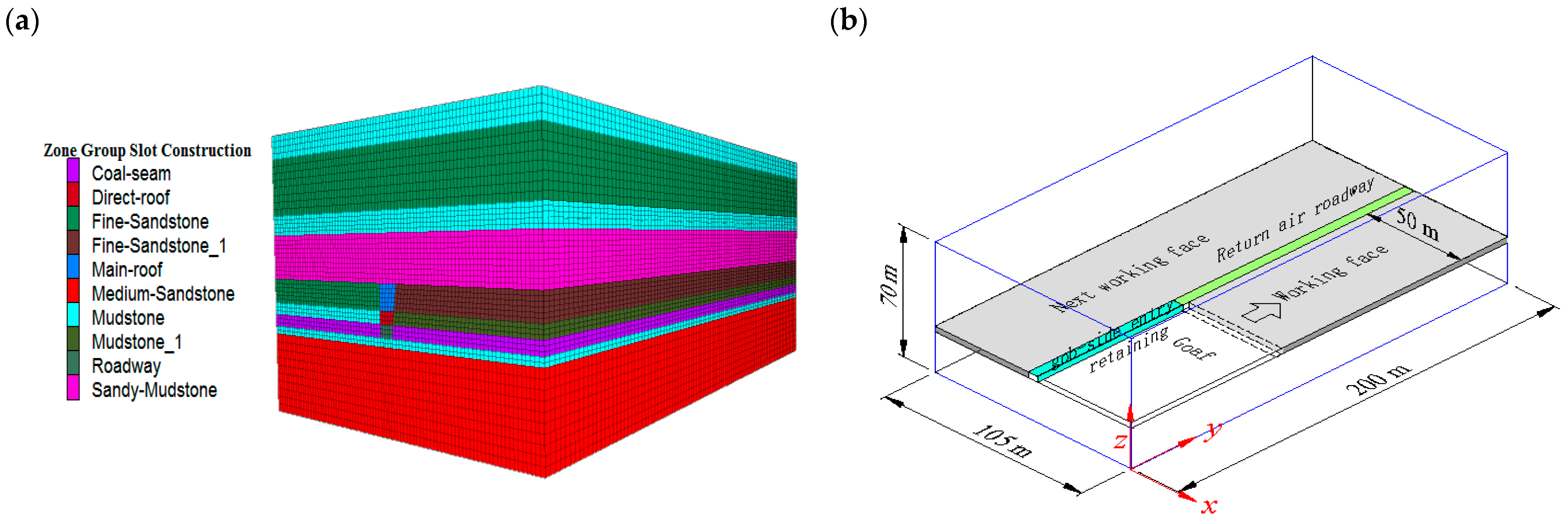

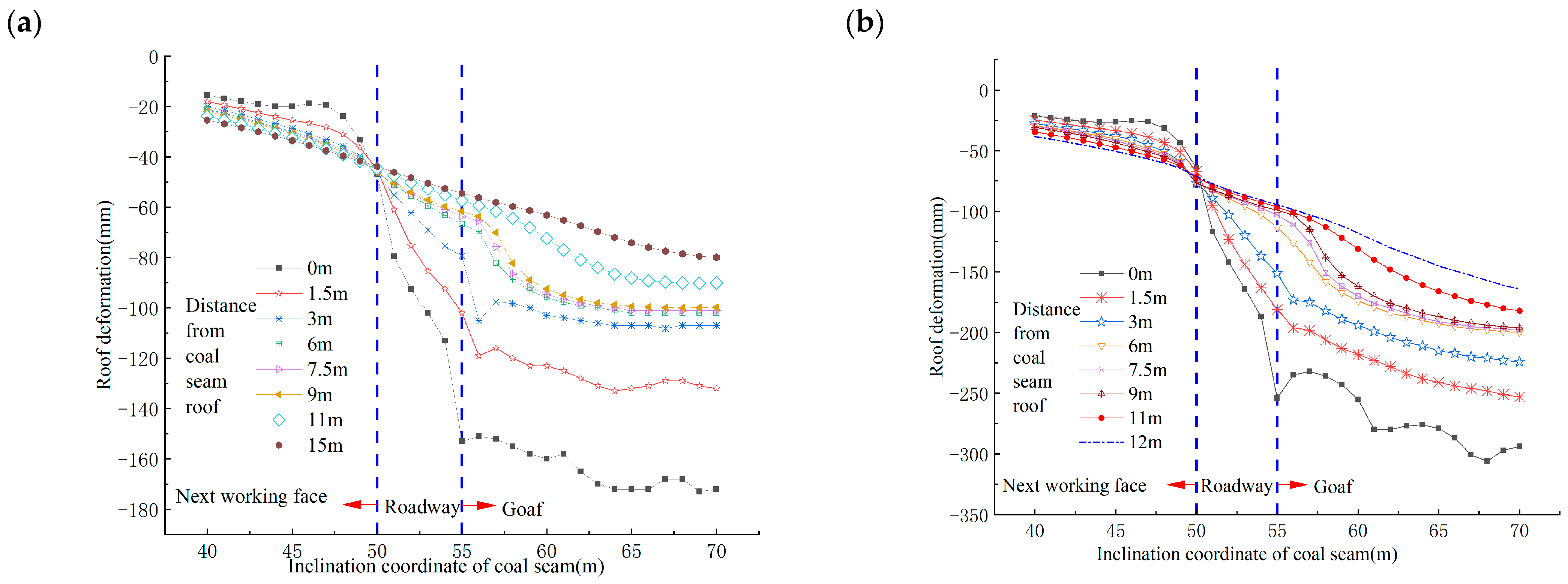




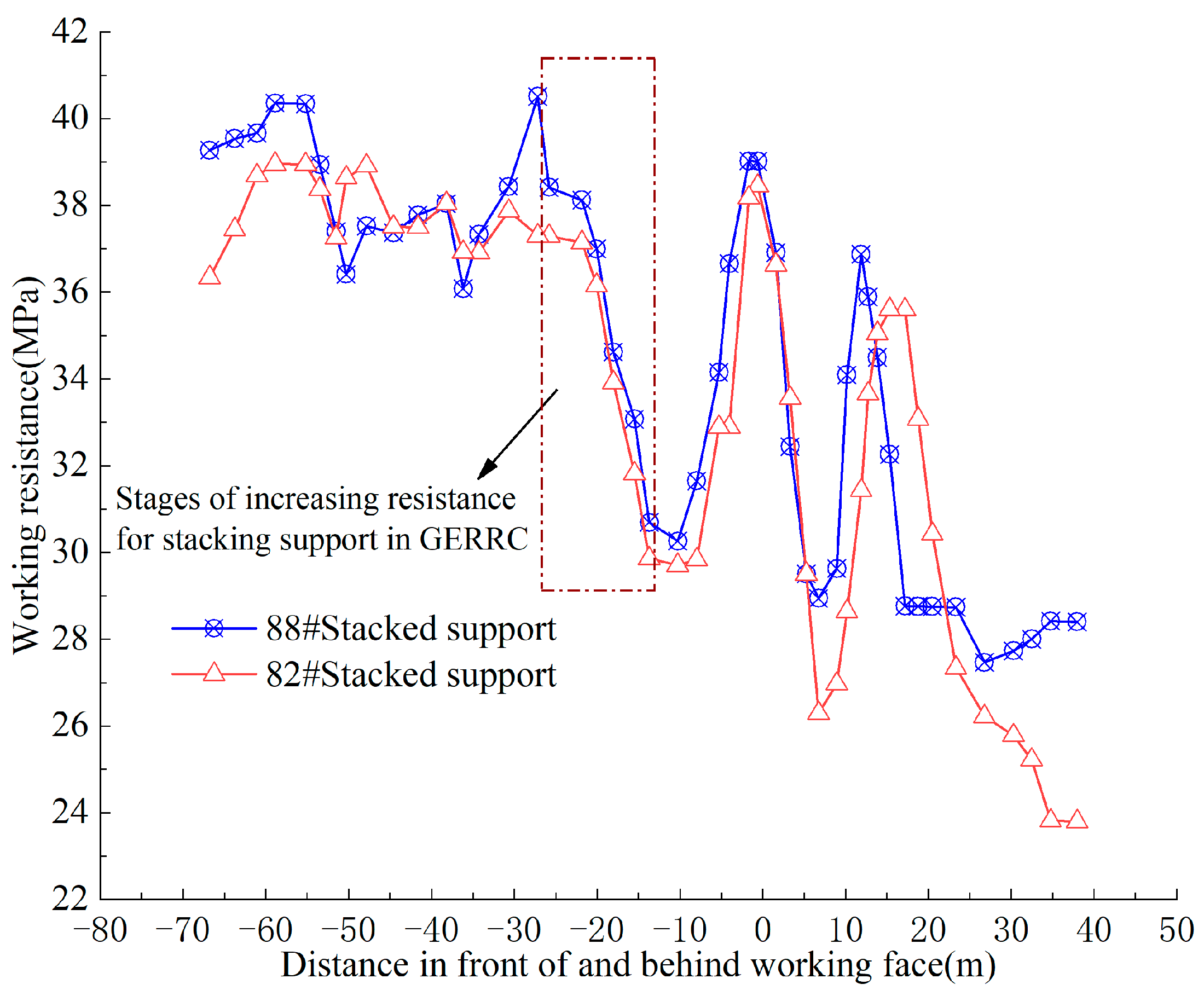
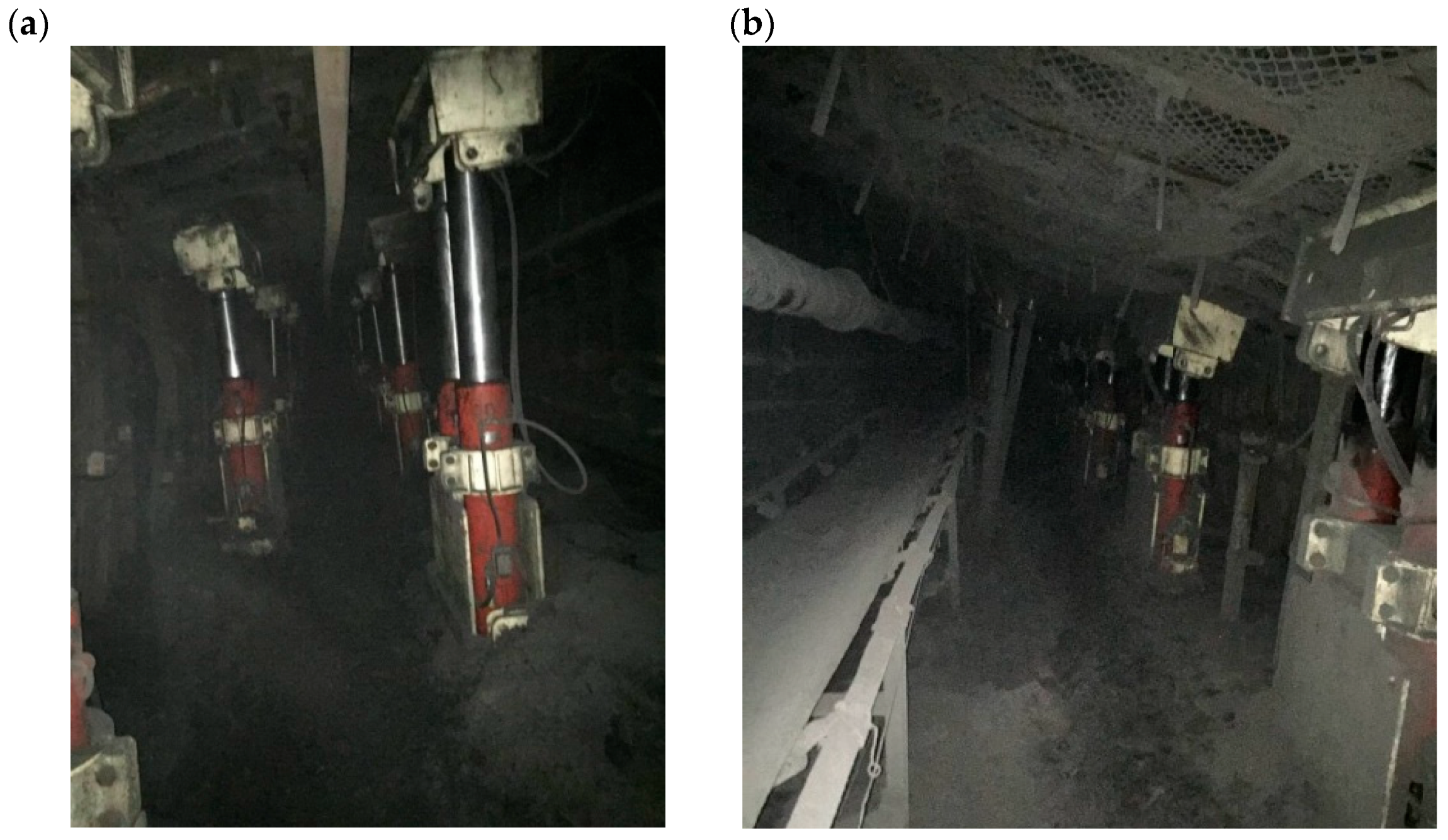
| Rock Strata Name | Layer Thickness /m | Density kN/m3 | Bulk Modulus GPa | Shear Modulus GPa | Internal Friction Angle (°) | Cohesion MPa | Tensile Strength MPa |
|---|---|---|---|---|---|---|---|
| Mudstone | 7 | 24 | 2.88 | 1.53 | 26 | 1.17 | 1.3 |
| Fine sandstone | 14 | 26 | 10.35 | 7.74 | 36 | 3.15 | 4.2 |
| Mudstone | 5 | 24 | 2.88 | 1.53 | 26 | 1.17 | 1.3 |
| Sandy mudstone | 11 | 25 | 3.6 | 1.89 | 29 | 1.35 | 2.1 |
| Fine sandstone | 6 | 26 | 10.35 | 7.74 | 36 | 3.15 | 4.2 |
| Sandy mudstone | 1.7 | 25 | 3.6 | 1.89 | 29 | 1.35 | 2.1 |
| Coal seam | 3.3 | 14 | 1.35 | 0.63 | 23 | 0.72 | 0.14 |
| Mudstone | 2 | 24 | 2.88 | 1.53 | 26 | 1.17 | 1.3 |
| Medium sandstone | 20 | 26 | 9.38 | 6.54 | 34 | 3.13 | 3.4 |
| Structural Name | Shear Stiffness N/m | Normal Stiffness N/m | Poisson Ratio | Internal Friction Angle /° |
|---|---|---|---|---|
| Structural surface | 1 × 108 | 2 × 106 | 0.25 | 15 |
| Support Position | 1. Strengthening Cable Bolts | 2. Cable Bolts Support Parameters | 3. Bolting Parameter | 4. Stacking Support | |||
|---|---|---|---|---|---|---|---|
| Support Specifications | Spacing between Rows | Support Specifications | Spacing between Rows | Support Specifications | Spacing between Rows | Support Parameters | |
| Behind the working face in GERRC | Steel strand, Φ21.6 mm × 12.3 m | Single row, 800 mm | Steel strand, Φ21.6 mm × 10.3 m | Make a step layout of the working face, 1.5 × 1.6 m | Screw thread steel, Φ20 mm × 2.4 m | 0.8 × 0.8 m | Double row |
Disclaimer/Publisher’s Note: The statements, opinions and data contained in all publications are solely those of the individual author(s) and contributor(s) and not of MDPI and/or the editor(s). MDPI and/or the editor(s) disclaim responsibility for any injury to people or property resulting from any ideas, methods, instructions or products referred to in the content. |
© 2024 by the authors. Licensee MDPI, Basel, Switzerland. This article is an open access article distributed under the terms and conditions of the Creative Commons Attribution (CC BY) license (https://creativecommons.org/licenses/by/4.0/).
Share and Cite
Liu, X.; Hua, X.; Liang, Y.; Li, C. Quantitative Research on Roof Deformation and Temporary Support Stiffness in Deep-Mine Gob-Side Entry Retaining by Roof Cutting. Appl. Sci. 2024, 14, 6520. https://doi.org/10.3390/app14156520
Liu X, Hua X, Liang Y, Li C. Quantitative Research on Roof Deformation and Temporary Support Stiffness in Deep-Mine Gob-Side Entry Retaining by Roof Cutting. Applied Sciences. 2024; 14(15):6520. https://doi.org/10.3390/app14156520
Chicago/Turabian StyleLiu, Xiao, Xinzhu Hua, Yuntao Liang, and Chen Li. 2024. "Quantitative Research on Roof Deformation and Temporary Support Stiffness in Deep-Mine Gob-Side Entry Retaining by Roof Cutting" Applied Sciences 14, no. 15: 6520. https://doi.org/10.3390/app14156520





